According to college student mental health statistics, around 1,100 US college students commit suicide every year and 24,000 attempt to take their lives.
College students are exposed to a lot of pressure and stress, which negatively impacts their mental health. In the past decade, the number of students treated for mental disorders has been on the rise. Experts confirm that things have worsened since the COVID-19 pandemic started.
The following statistics paint a clear picture of the situation in US colleges regarding mental health problems.
Key College Student Mental Health Statistics (Editor’s Choice)
- 64% of students drop out of college because of mental health problems.
- About 75% of mental illnesses appear by the age of 24.
- During COVID-19, nine in 10 students have experienced negative mental health symptoms.
- 48% of students believe that COVID-19 has impacted their education and mental health.
- About 65% of students were primarily worried about how long the pandemic would last.
- 41% of US college students have depression.
- 33% of students who receive mental health services consider suicide.
- Between 2% and 8% of college students are diagnosed with ADHD.
General Mental Health in College Students Statistics
1. 64% of students drop out of college because of mental health problems.
(NAMI)
In a survey conducted by the National Alliance on Mental Illness, a strong correlation between the number of students who drop out of college and depression was discovered. Around two-thirds (64%) of college students in the US quit their studies because of mental disorders. The study further revealed that 50% of those who dropped out didn’t access mental health services.
2. According to mental health clinicians, 25.7% of college student patients were concerned about their anxiety during the 2020–2021 academic school year.
(Statista)
Aside from anxiety, college mental health data revealed that 17% of students reported depression as a top concern, followed by stress (6.8%), relationship problems (6.3%), trauma (4.4%), family issues (4%), interpersonal functioning (3%), and grief (3%).
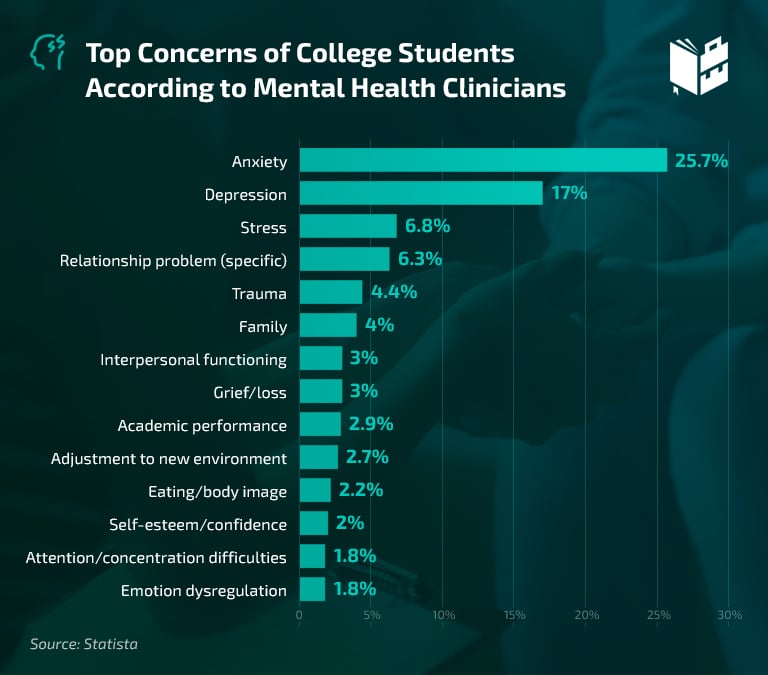
3. About 75% of mental illnesses are already established by the age of 24.
(NAMI)
The mental health of teenagers leaving home and entering a new environment is particularly vulnerable. According to college students and mental health statistics, 75% of mental health problems start by the age of 24. In most cases, symptoms emerge between 18 and 24 years of age.
4. Between 2% and 8% of college students are diagnosed with ADHD.
(NCBI)
Attention deficit hyperactivity disorder is one of the mental disorders that interfere with college student’s academic success. Students are unable to focus, pay attention in class, or study for exams. Additionally, people who struggle with symptoms of ADHD have higher odds of developing symptoms of anxiety and depression.
College Graduate Underemployment Rate
5. 24% of students are struggling with symptoms of bipolar disorder.
(NAMI)
Bipolar disorder is a lifelong condition characterized by extreme mood swings during manic episodes. It can have a negative impact on sleep, energy levels, and judgment. For that reason, patients need to stick to therapy and see a doctor regularly.
General College Student Mental Health Statistics — COVID-19 Edition
6. 87.1% of faculty members think their students’ mental health has worsened during the pandemic.
(Mary Christie Institute)
Nearly 90% of surveyed faculty members believe the pandemic has negatively influenced their students’ mental health. Therefore, 80% of them have had one-on-one conversations with students regarding their wellness and mental health. Still, only 51% agree or strongly agree that they know how to recognize if a student is in mental or emotional distress.
7. 73% of faculty members would like to have additional education on student mental health.
(Mary Christie Institute)
The majority of faculty members are open to the idea of professional development on the topic of student mental health. According to college students mental health statistics, 61% think basic training in responding to students who deal with emotional or mental distress should be mandatory, while 95% of students in college have faced negative mental health symptoms as a result of COVID-19
8. Over nine in 10 college students have experienced negative mental health symptoms during the pandemic.
(Best Colleges)
According to a survey, 95% of students in college have faced negative mental health symptoms as a result of COVID-19. About 37% feel their general mental health is affected. Additionally, 46% of students feel lonelier and more isolated. College mental health statistics also reveal that 45% of students feel more anxious, whereas 36% are more irritable and depressed.
College Graduate Underemployment Rate
9. 54% of college students think COVID-19 has impacted their mental health.
(Best Colleges)
The pandemic’s impact on mental health is obvious, but not all students have the same experience. For example, first-year students are more likely to report mental health issues related to the pandemic than senior students. Additionally, female students (60%) are more likely to report mental health problems triggered by the pandemic than male students (45%).
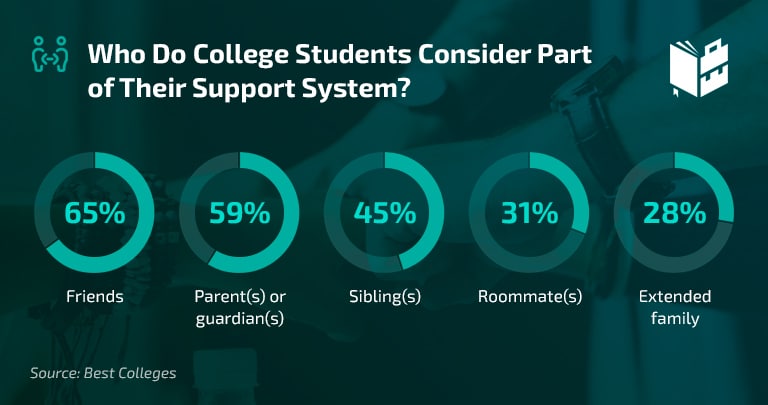
10. 65% of college students consider friends part of their support system.
(Best Colleges)
College students rely more on friends for emotional support. The latest mental illness in college students statistics show that 65% of students consider friends part of their support system compared to parents or guardians (59%). What’s more, students who experienced social isolation or loneliness throughout the year were 15% more likely to consider friends part of their support system.
11. 27% of male college students think that COVID-19-related mental health effects won’t last long.
(Best Colleges)
According to college student mental health statistics, more than a quarter of male students believe that the pandemic will only have a short-term effect on students’ mental health. On the other hand, 48% of female students are convinced that the pandemic will have a long-lasting impact.
12. 48% of college students think that the coronavirus pandemic has affected their education and mental health.
(Best Colleges)
The pandemic has taken a toll on education for nearly half of the students. About 46% of students struggle with burnout, whereas 37% find it difficult to attend classes on time. Additionally, statistics on mental illness in college students show that 52% of students struggle to finish homework, whereas 56% admit they have difficulty participating in class and engaging with other students.
College Graduate Underemployment Rate
13. Due to coronavirus, 78% of households with high school or college students have experienced disruptions.
(Best Colleges)
Coronavirus-related disruptions are mostly connected with closed campuses, people losing their jobs, and physical distancing. Unfortunately, all that has affected college students’ mental health. A whopping 81% of college students who have been affected by the pandemic say they’ve experienced increased stress.
14. In 2020, 65% of students were worried about how long the pandemic would last.
(The Jed Foundation)
The primary concern for 65% of students was how long the pandemic would last. As mental health in college statistics revealed, 61% were worried about racial turmoil in the country, whereas 60% were mainly concerned about how many people would become infected. Moreover, 56% had trouble taking care of their mental health, and 53% were worried about falling behind in academics.
15. According to 91% of surveyed college students, stress or anxiety are the most common ways that COVID-19 has impacted their lives.
(Active Minds)
For 91% of surveyed college students, stress or anxiety are the most common ways their lives have been affected by the coronavirus pandemic. College students’ health statistics show that 81% of students have reported disappointment or sadness. Additionally, 80% have felt isolated and lonely.
16. For 71% of students, listening to music is how they take care of their emotional health.
(The Jed Foundation)
Listening to music is the method students use the most to look after their emotional health. Nearly half (48%) of students surround themselves with friends, whereas 47% spend more time in nature. Furthermore, 46% of students get 7–9 hours of sleep every night, 39% find support in their families, and 37% eat right.
Statistics on Depression in College Students
17. The prevalence of depression among college students was 41% in 2021.
(Healthy Minds Network)
The rates of mental health disorders were generally high among college students before the pandemic. However, when it comes to depression, the prevalence increased by 5.2% from fall 2019 to spring 2020, reaching 40.9%. During the first couple of months of 2020, more students reported that their mental health negatively impacted their academic performance. According to the most recent data, the prevalence has only slightly increased in winter 2021 (41%).
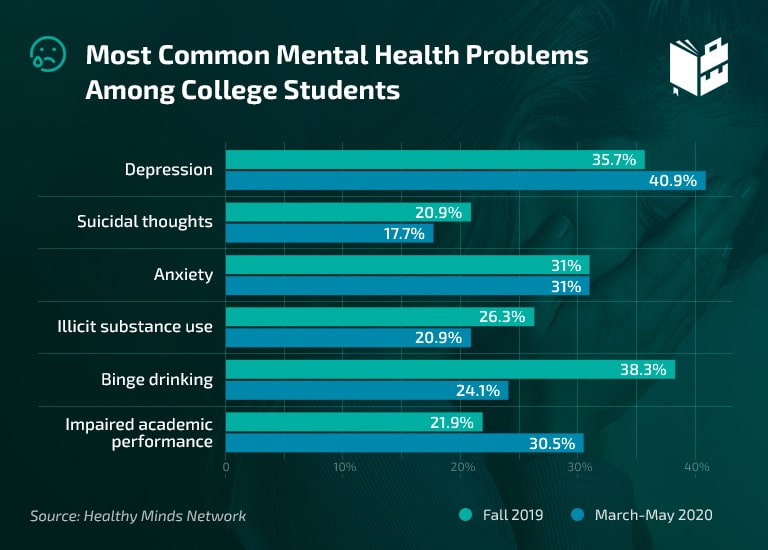
18. 22% of college students in the US are diagnosed with severe depression.
(Healthy Minds Network)
College student depression statistics unveil a critical issue among US students. According to a recent survey conducted by Healthy Minds Network, 22% of college students have screened positive for severe depression, and 19% have moderate symptoms of depression.
19. One-third of students who are diagnosed with depression drop out of college.
(Imagine America Foundation)
According to college depression statistics, around 33% of depressed students decide to drop out of college and abandon their studies. The School of Public Health at Boston University discovered that one-fifth of those students would have stayed in school if proper treatment had been provided. According to the same study, Gen Z-ers are more susceptible to developing mental health disorders such as manic depression.
20. 21.2% of college students who are diagnosed with depression will have lifelong symptoms.
(WHO)
The percentage of college students with depression experiencing lifelong symptoms is on the rise. According to the latest college student statistics, 21.2% of college students will continue to experience symptoms of depression for the rest of their lives. This mental health condition will not only prevent the affected students from achieving their academic goals, but it might negatively affect their quality of life. In such a case, long-term treatment is required.
College Graduate Underemployment Rate
21. The depression rates in college students during their first year of studies increased by 48% during the pandemic.
(UNC)
First-year college students were struggling the most during the pandemic. As a result, the depression rates increased by nearly 50%—from 21.5% pre-pandemic to 31.7% within the first four months of the pandemic. Instances of depression among Black students grew by a whopping 89%. According to recent data, these students found it challenging to adapt to learning online and struggled with social isolation.
College Student Mental Health Statistics 2022 — The Prevalence of Anxiety
22. 34% of college students have been diagnosed with anxiety.
(Healthy Minds Network)
Due to constant exposure to stress and trauma, many college students in the US are diagnosed with anxiety. To be precise, 34% of students are struggling with this mental health disorder. Of them, 17% have reported severe forms of anxiety, whereas 18% have moderate symptoms. Similar to depression, anxiety has a crippling effect on academic performance.
23. The prevalence of moderate-severe anxiety in first-year students increased to 25.3% during the first four months of the pandemic.
(Plos One)
As per the latest statistics on mental health in college students, the prevalence of moderate to severe anxiety in first-year students jumped from 18.1% pre-pandemic to 25.3% within the first four months of the pandemic. According to research, white, female, and SGM students were at the highest risk of increased anxiety.
24. According to 35% of surveyed college students, campus closures and the shift to online learning have contributed to increased anxiety.
(Best Colleges)
On a more positive note, mental health in college students statistics indicate that 69% of students experiencing disruptions think that schools provide enough support during the transition process. Furthermore, online learning takes 40%–60% less time than traditional education.
25. 82% of students reported struggling with anxiety during the pandemic.
(The Jed Foundation)
According to a 2020 study, the vast majority of students struggling with their mental health experienced increased anxiety, followed by depression (63%), trouble concentrating (62%), and inability to cope with stress (60%). Anxiety in college students statistics revealed that 16% of students said their mental health improved towards the end of 2020 compared to the beginning of the pandemic.
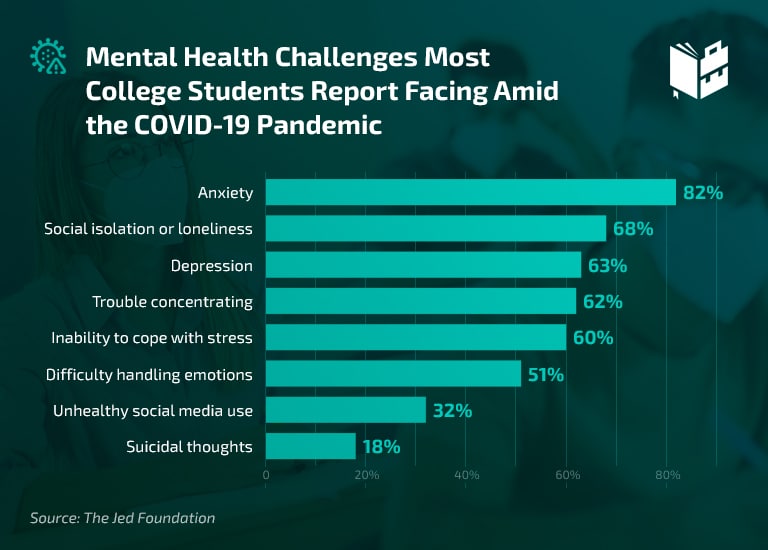
26. 25% of students enrolled in four-year studies said they felt slightly anxious about COVID-19.
(College Pulse)
About 56% of students felt at least somewhat anxious regarding COVID-19, with 20% reporting they felt very anxious. Additionally, 25% reported slight anxiety, and only 17% said they weren’t anxious at all. Female students experienced more severe anxiety than male students—26% vs. 14%, respectively.
College Student Suicide Rate
27. Male college students are four to six times more likely to commit suicide than female college students.
(Governors State University, NCBI)
Self-harm and suicide attempts are common consequences of anxiety and depression. Students who fall into despair and feel hopeless are more likely to consider suicide as a way out. Over 90% of people who commit suicide have depression or substance use disorder. In addition, suicide is the second leading cause of death among college students in the United States.
28. Suicide rates of college students have tripled since the 1950s.
(NCBI, CDC)
College is a period of transition during which students face stress as they’re adjusting to a new environment away from their support systems. Environmental stressors combined with a predisposition to mental health issues can increase the chances of suicide. In fact, since the 1950s, suicide rates have tripled. Between 2007 and 2018, the rate of suicide among young people aged 10–24 jumped by 57.4%.
29. In the 2020–2021 school year, 33% of students receiving mental health services considered suicide.
(Statista)
According to mental health on college campuses statistics, between 2020 and 2021, the number of students receiving mental health services and considering suicide has dropped for the first time in 10 years. For comparison, the rate of suicidal ideation was 24% in the 2010–2011 school year. From there, it started increasing gradually, reaching 36.9% in 2019–2020.
College Graduate Underemployment Rate
30. 30% of gay or bisexual students aged 18–25 have attempted suicide.
(NBC News)
The college students’ suicide rate is higher among sexual minorities. Recent data indicates that gay and bisexual college studnets are five times as likely as their straight peers to attempt suicide. Over a third of bisexual or gay students have attempted suicide due to a high level of psychological distress, victimization, and homophobia.
31. 13% of students thought about suicide in 2021.
(Healthy Minds Network)
About 13% of students had suicidal ideation, and 5% had suicidal plans in 2021. Of them, 1% of students attempted suicide. Additionally, 23% experienced non-suicidal self-injury.
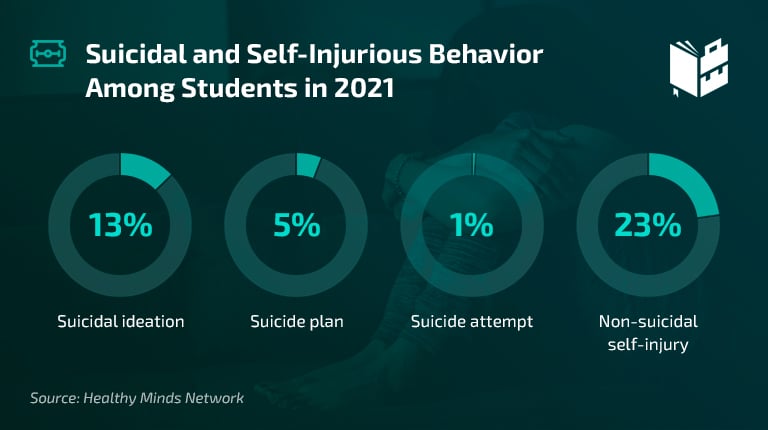
Conclusion
All of the above-mentioned college student mental health statistics paint an upsetting picture. Coping with new challenges and excessive academic demands often result in burnout, leading to stress and anxiety. On top of that, the novel coronavirus contributed to growing despair among students, worsening their mental health.
Universities and colleges need to find innovative ways to promote students’ well-being. Ensuring a safe school environment, reinforcing positive behaviors, and building resilience are good starting points. Furthermore, institutions need to place more emphasis on educating students, parents, and staff about the warning signs of mental illness and what to do about them.